Frigidaire PLGFZ397GC Owners Manual
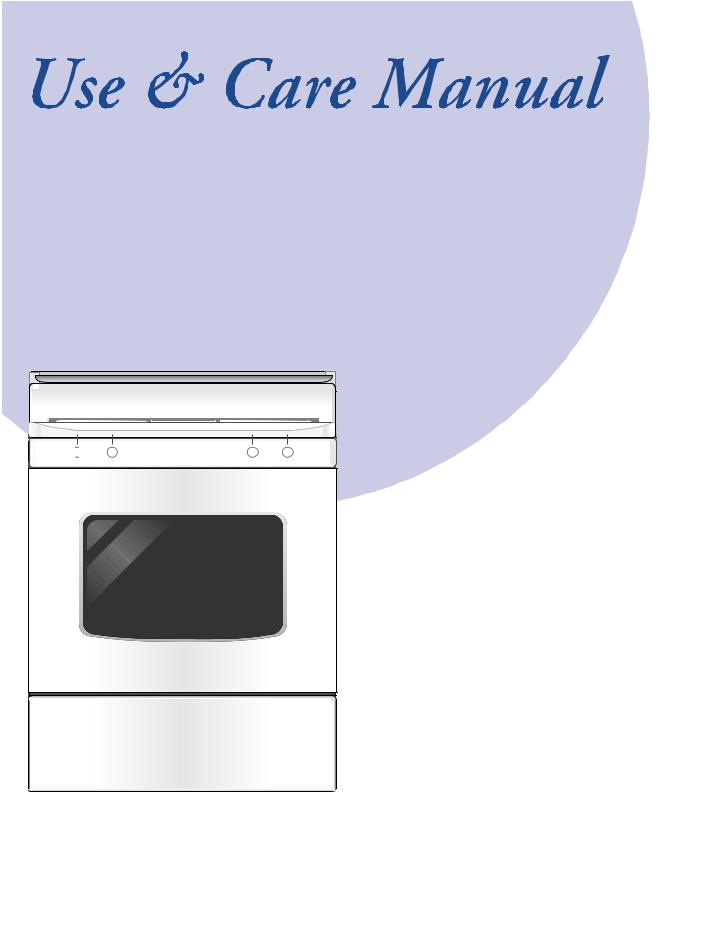
Visit the Frigidaire Web Site at: http://www.frigidaire.com
Gas
Range
ES530 Control, Self-Cleaning Oven
with Deep Well Style Cooktop
Welcome.......................................... |
2 |
Important Safety Instructions ..... |
3-4 |
Features at a Glance ...................... |
5 |
Before Setting Oven Controls ....... |
6 |
Setting Surface Controls ............... |
7 |
Warming Drawer Controls .......... |
8-9 |
Control Pad Features ................... |
10 |
Setting Oven Controls............. |
11-24 |
Self Cleaning........................... |
25-27 |
Adjusting Oven Temperature....... |
27 |
General Care & Cleaning ....... |
28-30 |
Questions or for Service Call: |
|
|
|
|
Before You Call |
|
|
1-800-944-9044 (U.S.) |
|
|
|
|
Solutions to Common Problems |
........................ 31 |
|
1-800-668-4606 (Canada) |
|
|
|
|
Warranty ......................... |
|
Back Page |
READ AND SAVE THESE INSTRUCTIONS |
|
p/n 316417171 Rev A (0906) |
|
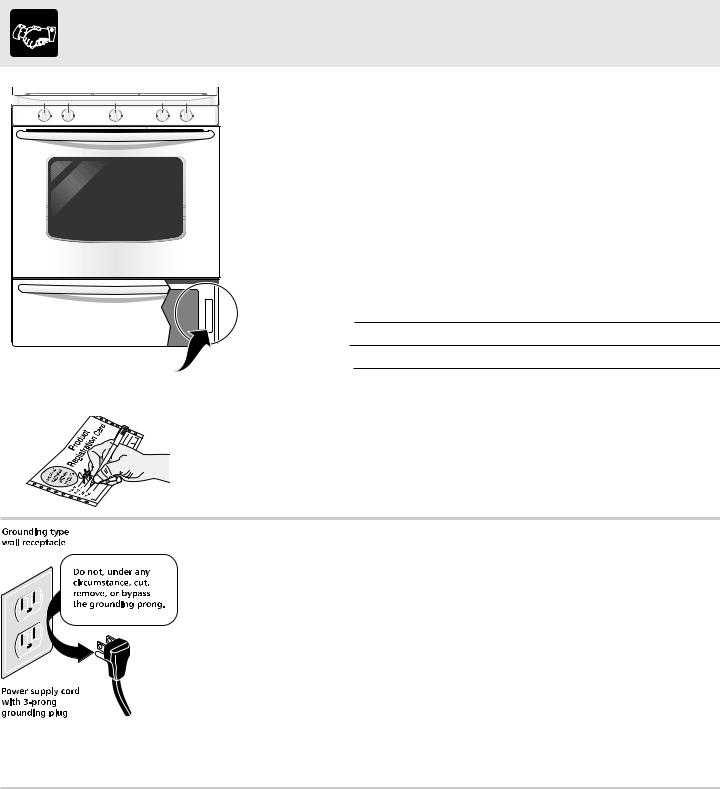
Welcome & Congratulations
Congratulations on your purchase of a new range! At Electrolux Home Products, we are very proud of our product and are completely committed to providing you with the best service possible. Your satisfaction is our number one priority.
We know you’ll enjoy your new range and Thank You for choosing our product.
We hope you consider us for future purchases.
PLEASE CAREFULLY READ AND SAVE THESE INSTRUCTIONS
This Use & Care Manual provides specific operating instructions for your model. Use your range only as instructed in this manual. These instructions are not meant to cover every possible condition and situation that may occur. Common sense and caution must be practiced when installing, operating and maintaining any appliance.
Please record your model and serial numbers below for future reference.
Serial plate location -
Open the Warming Drawer (some models) or Storage Drawer (some models).
Model Number:
Serial Number:
Purchase Date:
This Use & Care Manual contains general operating instructions for your appliance and feature information for several models. Your range may not have all the described features. The graphics shown are representative. The graphics on your range may not look exactly like those shown.
Product Registration
Be sure to register your product. The self-addressed PRODUCT REGISTRATION
CARD should be filled in completely, signed and returned to Electrolux Home Products.
Grounding Instructions
 Avoid fire hazard or electrical shock. Do not use an adapter plug, an extension cord, or remove grounding prong from electrical power cord. Failure to follow this warning can cause serious injury, fire or death.
Avoid fire hazard or electrical shock. Do not use an adapter plug, an extension cord, or remove grounding prong from electrical power cord. Failure to follow this warning can cause serious injury, fire or death.
 This appliance is equipped with a 3-prong grounding plug for your protection against shock hazard and should be plugged directly into a properly grounded receptacle. DO NOT cut or remove the grounding prong from this plug.
This appliance is equipped with a 3-prong grounding plug for your protection against shock hazard and should be plugged directly into a properly grounded receptacle. DO NOT cut or remove the grounding prong from this plug.
For personal safety, the range must be properly grounded. For maximum safety, the power cord must be plugged into an electrical outlet that is correctly polarized and properly grounded. If a 2-prong wall receptacle is the only available outlet, it is the personal responsibility of the consumer to have it replaced with a properly grounded 3-prong wall receptacle installed by a qualified electrician.
See the INSTALLATION INSTRUCTIONS packaged with this range for complete installation and grounding instructions.
Conversion to Liquefied Petroleum Gas (or L.P. Gas)


 Personal injury or death from electrical shock may occur if the range is not installed by a qualified installer or electrician.
Personal injury or death from electrical shock may occur if the range is not installed by a qualified installer or electrician.
The natural gas range is designed to allow for conversion to Liquefied Petroleum (L.P.) Gas.


 Any additions, changes or conversions required in order for this appliance to satisfactorily meet the application needs must be made by a qualified technician.
Any additions, changes or conversions required in order for this appliance to satisfactorily meet the application needs must be made by a qualified technician.
©2006 Electrolux Home Products, Inc. All rights reserved
If L.P. conversion is needed, contact your local appliance dealer for assistance. The L.P. Conversion Kit may be obtained from your appliance dealer and should be installed by a qualified service technician. Before installing the kit be sure to follow the L.P. Installation Instructions carefully.
2
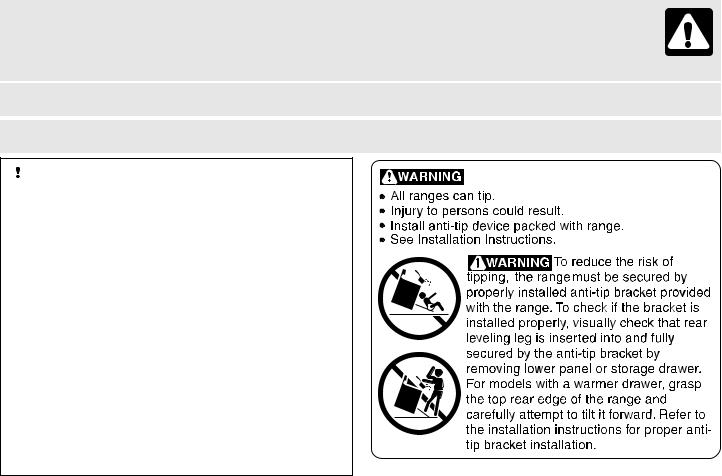
Important Safety Instructions
Read all instructions before using this appliance. Save these instructions for future reference.
This manual contains important safety symbols and instructions. Please pay attention to these symbols and follow all instructions given.




 This symbol will help alert you to situations that may cause serious bodily harm, death or property damage.
This symbol will help alert you to situations that may cause serious bodily harm, death or property damage.




 This symbol will help alert you to situations that may cause bodily injury or property damage.
This symbol will help alert you to situations that may cause bodily injury or property damage.
 If the information in this manual is not followed exactly, a fire or explosion may result causing property damage, personal injury or death.
If the information in this manual is not followed exactly, a fire or explosion may result causing property damage, personal injury or death.
FORYOURSAFETY:
—Do not store or use gasoline or other flammable vapors and liquids in the vicinity of this or any other appliance.
—WHAT TO DO IF YOU SMELL GAS:
•Do not try to light any appliance.
•Do not touch any electrical switch; do not use any phone in your building.
•Immediately call your gas supplier from a neighbor's phone. Follow the gas supplier's instructions.
•If you cannot reach your gas supplier, call the fire department.
—Installation and service must be performed by a qualified installer, servicer or the gas supplier.
•Remove all tape and packaging before using the range.
Destroy the carton and plastic bags after unpacking the range. Never allow children to play with packaging material.
•Proper Installation—Be sure your appliance is properly installed and grounded by a qualified technician in accordance with the National Fuel Gas Code ANSI Z223.- latest edition, or in Canada CAN/CGA B149.1, and CAN/CGA B149.2, and the the National Electrical Code ANSI/NFPA No.70-latest edition, or in Canada CSA Standard C22.1, Canadian Electrical Code, Part 1, and local code requirements. Install only per installation instructions provided in the literature package for this range.
Ask your dealer to recommend a qualified technician and an authorized repair service. Know how to disconnect the power to the range at the circuit breaker or fuse box in case of an emergency.
•User servicing—Do not repair or replace any part of the appliance unless specifically recommended in the manuals.
All other servicing should be done only by a qualified technician, This may reduce the risk of personal injury and damage to the range.
•Never modify or alter the construction of a range by removing leveling legs, panels, wire covers, anti-tip brackets/screws, or any other part of the product.




 NEVER use this appliance as a space heater to heat or warm the room. Doing so may result in carbon monoxide poisoning.
NEVER use this appliance as a space heater to heat or warm the room. Doing so may result in carbon monoxide poisoning.




 NEVER cover any slots, holes or passages in the oven bottom or cover an entire rack with materials such as aluminum foil. Doing so blocks air flow through the oven and may cause carbon monoxide poisoning. Aluminum foil linings may trap heat, causing a fire hazard.
NEVER cover any slots, holes or passages in the oven bottom or cover an entire rack with materials such as aluminum foil. Doing so blocks air flow through the oven and may cause carbon monoxide poisoning. Aluminum foil linings may trap heat, causing a fire hazard.
 Stepping, leaning or sitting on the doors or drawers of this range can result in serious injuries and also cause damage to the range. Do not allow
Stepping, leaning or sitting on the doors or drawers of this range can result in serious injuries and also cause damage to the range. Do not allow
children to climb or play around the range. The weight of a child on an open door may cause the range to tip, resulting in serious burns or other injury.
 Do not use the oven or warmer drawer (if equipped) for storage.
Do not use the oven or warmer drawer (if equipped) for storage.
 Do not store items of interest to children in the cabinets above a range or on the backguard of a range. Children climbing on the range to reach items could
Do not store items of interest to children in the cabinets above a range or on the backguard of a range. Children climbing on the range to reach items could
be seriously injured.
 Never Use Your Appliance for Warming or Heating the Room.
Never Use Your Appliance for Warming or Heating the Room.
•Storage in or on Appliance—Flammable materials should not be stored in an oven, warmer drawer, near surface burners or in the storage drawer. This includes paper, plastic and cloth items, such as cookbooks, plasticware and towels, as well as flammable liquids. Do not store explosives, such as aerosol cans, on or near the range.
3

Important Safety Instructions
•Do Not Leave Children Alone—Children should not be left alone or unattended in the area where appliance is in use.
They should never be allowed to sit or stand on any part of the appliance.
•DONOTTOUCHSURFACEBURNERS,AREASNEARTHESE BURNERS,OVENBURNERSORINTERIORSURFACESOFTHE OVEN. Both surface and oven burners may be hot even though flames are not visible. Areas near surface burners may become hot enough to cause burns. During and after use, do not touch, or let clothing or other flammable materials touch these areas until they have had sufficient time to cool. Among these areas are the cook top, surfaces facing the cook top, the oven vent openings and surfaces near these openings, oven door and window.
•Wear Proper Apparel—Loose-fitting or hanging garments should never be worn while using the appliance. Do not let clothing or other flammable materials contact hot surfaces.
•Do Not Use Water or Flour on Grease Fires—Smother the fire with a pan lid, or use baking soda, a dry chemical or foam-type extinguisher.
•When heating fat or grease, watch it closely. Fat or grease may catch fire if allowed to become too hot.
•Use Only Dry Potholders—Moist or damp potholders on hot surfaces may result in burns from steam. Do not let potholders touch hot heating burners. Do not use a towel or other bulky cloth instead of a potholder.
•Do Not Heat Unopened Food Containers—Buildup of pressure may cause container to burst and result in injury.
•Remove the oven door from any unused range if it is to be stored or discarded.
IMPORTANT—ELECTRICIGNITIONMODELSONLY:Do not attempt to operate the oven during a power failure. If the power fails, always turn off the oven. If the oven is not turned off and the power resumes, the oven will begin to operate again. Once the power resumes, reset the clock and oven function.
IMPORTANT INSTRUCTIONS FOR USING YOUR COOKTOP
 Use Proper Flame Size—Adjust flame size so it does not extend beyond the edge of the utensil. The use of undersized utensils will expose a portion of the burner flame to direct contact and may result in ignition of clothing. Proper relationship of utensil to flame will also improve efficiency.
Use Proper Flame Size—Adjust flame size so it does not extend beyond the edge of the utensil. The use of undersized utensils will expose a portion of the burner flame to direct contact and may result in ignition of clothing. Proper relationship of utensil to flame will also improve efficiency.
•Know which knob controls each surface burner. Place a pan of food on the burner before turning it on, and turn the burner off before removing the pan.
•Always turn knob to the full LITE position when igniting top burners. Visually check that burner has lit. Then adjust the flame
so it does not extend beyond the edge of the utensil.
•Utensil Handles Should Be Turned Inward and Not Extend Over Adjacent Surface Burners—To reduce the risk of burns, ignition of flammable materials, and spillage due to unintentional contact with the utensil, the handle of the utensil should be positioned so that it is turned inward, and does not extend over adjacent surface burners.
•Never Leave Surface Burners Unattended at High Heat Settings—Boilovers cause smoking and greasy spillovers that may ignite, or a pan that has boiled dry may melt.
•Protective Liners—Do not use aluminum foil to line surface burner pans, or oven bottom, except as suggested in this manual. Improper installation of these liners may result in risk of electric shock, or fire.
•Glazed Cooking Utensils—Only certain types of glass, glass/ ceramic, ceramic, earthenware, or other glazed utensils are suitable for cooktop service without breaking due to the sudden change in temperature. Check the manufacturer’s recommendations for cooktop use.
IMPORTANT INSTRUCTIONS FOR USING YOUR OVEN
•Use Care When Opening Oven Door or Warmer Drawer—
Stand to the side of the range when opening the door of a hot oven. Let hot air or steam escape before you remove or replace food in the oven.
•Keep Oven Vent Ducts Unobstructed. The oven vent is located below the backguard. Touching the surfaces in this area when the oven is operating may cause severe burns. Also, do not place plastic or heat-sensitive items on or near the oven vent. These items could melt or ignite.
•Placement of Oven Racks. Always place oven racks in desired location while oven is cool. If rack must be moved while oven is hot use extreme caution. Use potholders and grasp the rack with both hands to reposition. Do not let potholders contact the hot heating elements in the oven. Remove all utensils from the rack before moving.
•Do not use the broiler pan without its insert. The broiler pan and its insert allow dripping fat to drain and be kept away from the high heat of the broiler.
•Do not cover the broiler insert with aluminum foil. Exposed fat and grease could ignite.
•Cold temperatures can damage the electronic control. When using the appliance for the first time, or when the appliance has not been used for an extended period of time, be certain the unit has been in temperatures above 32°F (0°C) for at least 3 hours before turning on the power to the appliance.
IMPORTANT INSTRUCTIONS FOR CLEANING YOUR RANGE
•Clean the range regularly to keep all parts free of grease that could catch fire. Pay particular attention to the area underneath each surface element. Do not allow grease to accumulate. Refer to the range manufacturer’s instructions for cleaning.
•Kitchen cleaners and aerosols—Always follow the manufacturer’s recommended directions for use. Be aware that excess residue from cleaners and aerosols may ignite causing damage and injury.
SELF CLEANING OVENS
•Clean in the self-cleaning cycle only the parts listed in this Owner’s Guide. Before self cleaning the oven, remove the broiler pan and any utensils or foods from the oven.
•Do Not Use Oven Cleaners—No commercial oven cleaner or oven liner protective coating of any kind should be used in or around any part of the oven.
•Do Not Clean Door Gasket—The door gasket is essential for a good seal. Care should be taken not to rub, damage or move the gasket.
Important Safety Notice
The California Safe Drinking Water and Toxic Enforcement Act requires the Governor of California to publish a list of substances known to the state to cause cancer, birth defects or other reproductive harm, and requires businesses to warn customers of potential exposure to such substances.
4
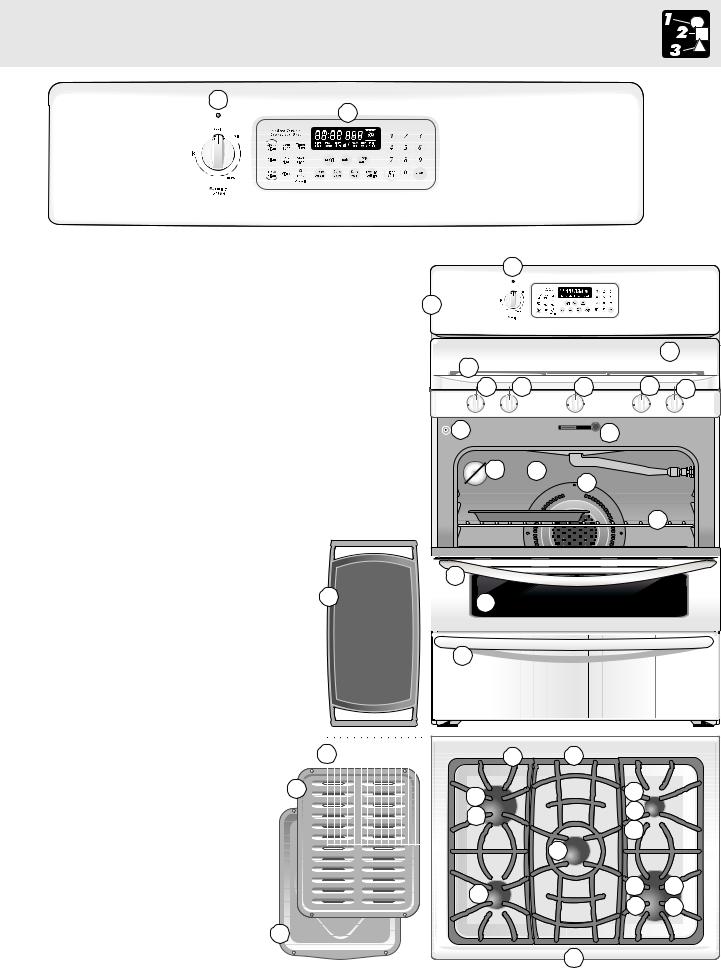
Features At A Glance
2
1
Your Gas Range Features Include:
1. Electronic Oven Control with Kitchen Timer.
2. Warming Drawer Control & Indicator Light (some models). 3. Left Front Burner Valve & Knob.
4. Left Rear Burner Valve & Knob.
5. Center Burner Valve & Knob (some models).
6. Right Rear Burner Valve & Knob.
7. Right Front Burner Valve & Knob.
8. Easy to clean Deep Well style cooktop.
9. Dishwasher safe Burner Grates (styles & colors vary by model).
10. Dishwasher safe Center Burner Grate (some models)
11. Self-Clean Oven Door Latch.
12. Automatic Oven Door Light Switch (some models).
13. Oven Interior Light with Shield.
14. Self-Cleaning Oven interior.
15. Adjustable Oven Rack(s).
16. Convection Fan & Cover.
17. Large 1 piece Oven Door Handle.
18. Full width Oven Door (styles vary with model).
19. Warming Drawer and Handle (some
29
models) or Storage Drawer with integrated handle (some models).
20.5,000 BTU Simmer Burner (some models).
21.9,500 BTU Burner (some models).
22.12,000 BTU Power Plus Burner (some models).
23.14,000 BTU Power Plus Burner (some models).
24.16,000 BTU Power Plus Burner (some
|
models). |
28 |
25. |
9,500 BTU Accent Burner (some models). |
|
26. |
Broil Pan (some models). |
27 |
27. |
Broil Pan Insert (some models). |
|
28. |
Roasting Rack. |
|
29. |
Center Griddle Grate |
|
30. |
Leveling Legs & Anti-tip Bracket |
|
|
(included). |
|
|
Burner Drip pans (some models). |
|
NOTE: The features of your range may |
26 |
|
vary according to model type & color. |
|
|
5
|
2 |
|
|
|
8 |
|
|
|
|
|
|
|
10 |
|
9 |
|
|
|
|
3 |
4 |
5 |
6 |
7 |
12 |
|
|
11 |
|
13 |
|
14 |
|
|
|
|
16 |
|
|
|
|
|
15 |
|
17 |
|
|
|
|
18 |
|
|
|
|
19 |
9 |
10 |
|
|
21 |
20 |
|
|
21 |
|
||
22 |
|
||
23 |
|
||
|
|
||
|
25 |
|
|
21 |
21 |
23 |
|
22 |
24 |
||
|
|||
|
8 |
|
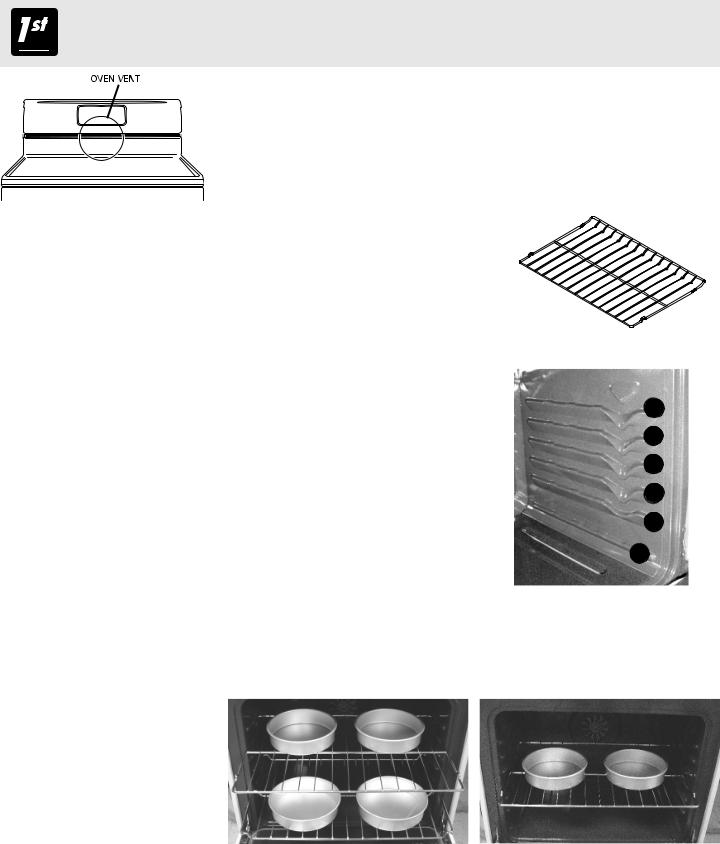
Before Setting Oven Controls
Oven Vent Location
The oven vent is located below the backguard (See Fig. 1). When the oven is on, warm air is released through this vent. This venting is necessary for proper air
circulation in the oven and good baking results. DO NOT BLOCK THE VENT.
Removing & Replacing Oven Racks
To remove, pull the rack forward until it stops. Lift up front of rack and slide out. Fig. 1 To replace, fit the rack onto the guides on the oven walls. Tilt the front of the rack
upward and slide the rack back into place.
Oven Racks
Your range is equipped with one or more Flat Oven Rack(s). Place the rack(s) into the positions shown in Fig. 2. Refer to the following
Recommended Rack Positions for Broiling, Baking & Roasting for complete information.
Arranging Oven Racks
Flat
Oven Rack
Fig. 2
ALWAYS ARRANGE OVEN RACKS WHEN THE OVEN IS COOL (PRIOR TO OPERATING THE OVEN). Always use oven mitts when using the oven.
Recommended Rack Positions for Broiling, Baking & Roasting:
Food |
Rack Position |
|
Broiling hamburgers & steaks |
See Broil section |
|
|
||
Broiling meats, chicken or fish |
See Broil section |
|
Cookies, cakes, pies, biscuits & muffins |
3 or 4 |
|
Frozen pies, angel food cake, yeast, bread, casseroles, |
|
|
small cuts of meat or poultry |
1 or 2 |
|
Turkey, roast or ham |
||
|
Baking Layer Cakes with 1 or 2 Oven Racks
6
5
4
3
2
1
Fig. 3
For best results when baking cakes using 2 oven racks, place cookware on rack positions 2 & 5 (See Figs. 3 & 4). For best results when using a single oven Flat Rack, place cookware on rack position 3 or 4 (See Figs. 3 & 5).
Air Circulation in the Oven
For best air circulation and baking |
|
|
results allow 2-4" (5-10 cm) around |
|
|
the cookware for proper air |
|
|
circulation and be sure pans and |
|
|
cookware do not touch each other, |
|
|
the oven door, sides or back of the |
|
|
oven cavity. The hot air must be |
|
|
able to circulate around the pans |
|
|
and cookware in the oven for even |
|
|
heat to reach around the food. |
Fig. 4 |
Fig. 5 |
6
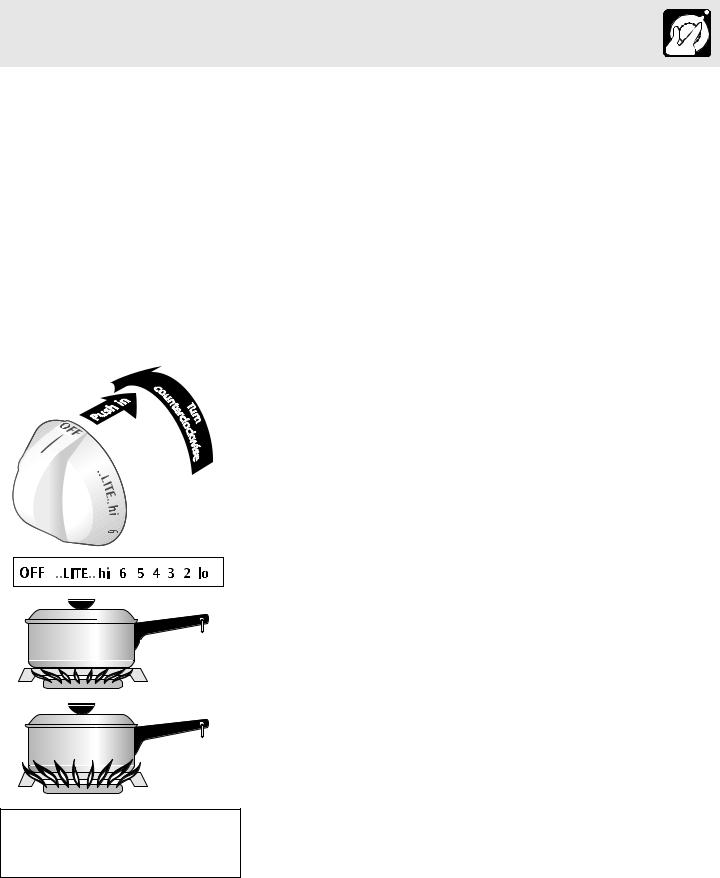
Setting Surface Controls
 Do not place plastic items such as salt and pepper shakers, spoon holders or plastic wrappings on top of the range when it is in use. These items could melt or
Do not place plastic items such as salt and pepper shakers, spoon holders or plastic wrappings on top of the range when it is in use. These items could melt or
ignite. Potholders, towels or wood spoons could catch fire if placed too close to a flame.
In the event of an electrical power outage, the surface burners can be lit manually. To light a surface burner, hold a lit match to the burner head, then
slowly turn the surface control knob to LITE. After burner lights push in and turn
knob to desired setting. Use caution when lighting surface burners manually.
Setting Surface Controls
Your range may be equipped with different sized surface burners. The ability to heat food quicker and in larger volumes increases as the burner size increases.
The SIMMER burner (some models) is best used for simmering delicate food items such as sauces, etc.
The standard burners can be used for most surface cooking needs. Some models include a standard sized center burner (or 5th burner).
The POWER PLUS burner or burners (some models) are best used for bringing large quantities of liquid to temperature and when preparing larger quantities of food.
Regardless of size, always select cookware that is suitable for the amount and type of food being prepared. Select a burner and flame size appropriate to the pan. Never allow flames to extend beyond the outer edge of the pan.
Operating the Gas Surface Burners:
CORRECT
INCORRECT
Never extend the flame beyond the outer edge of the utensil. A higher flame simply wastes heat and energy, and increases your risk of being burned by the flame.
1.Place cooking utensil on surface burner.
2.Push the surface control knob in and turn counterclockwise out of the OFF position.
3.Release the knob and rotate to the LITE position. Note: All four electronic surface ignitors will spark at the same time. However, only the burner you are turning on will ignite.
3.Visually check that the burner has lit.
4.Push the control knob in and turn counterclockwise to the desired flame
size. The control knobs do not have to be set at a particular setting. Use the guides and adjust the flame as needed. DO NOT cook with the surface control knob in the LITE position. (The electronic ignitor will continue to spark if the knob is left in the LITE position.)
Setting Proper Surface Burner Flame Size
For most cooking, start on the highest control setting and then turn to a lower one to complete the process. Use the recommendations below as a guide for determining proper flame size for various types of cooking. The size and type of utensil used and the amount of food being cooked will influence the setting needed for cooking.
*Flame Size |
Type of Cooking |
High Flame |
Start most foods; bring water to a boil; pan broiling. |
Medium Flame |
Maintain a slow boil; thicken sauces, gravies; steaming. |
Low Flame |
Keep foods cooking; poach; stewing. |
For deep fat frying, use a thermometer and adjust the surface control knob accordingly. If the fat is too cool, the food will absorb the fat and be greasy. If the fat is too hot, the food will brown so quickly that the center will be undercooked. Do not attempt to deep fat fry too much food at once as the food will neither brown nor cook properly.
*These settings are based on using medium-weight metal or aluminum pans with lids. Settings may vary when using other types of pans. The color of the flame is the key to proper burner adjustment. A good flame is clear, blue and
hardly visible in a well-lighted room. Each cone of flame should be steady and sharp. Adjust or clean burner if flame is yellow-orange.
7
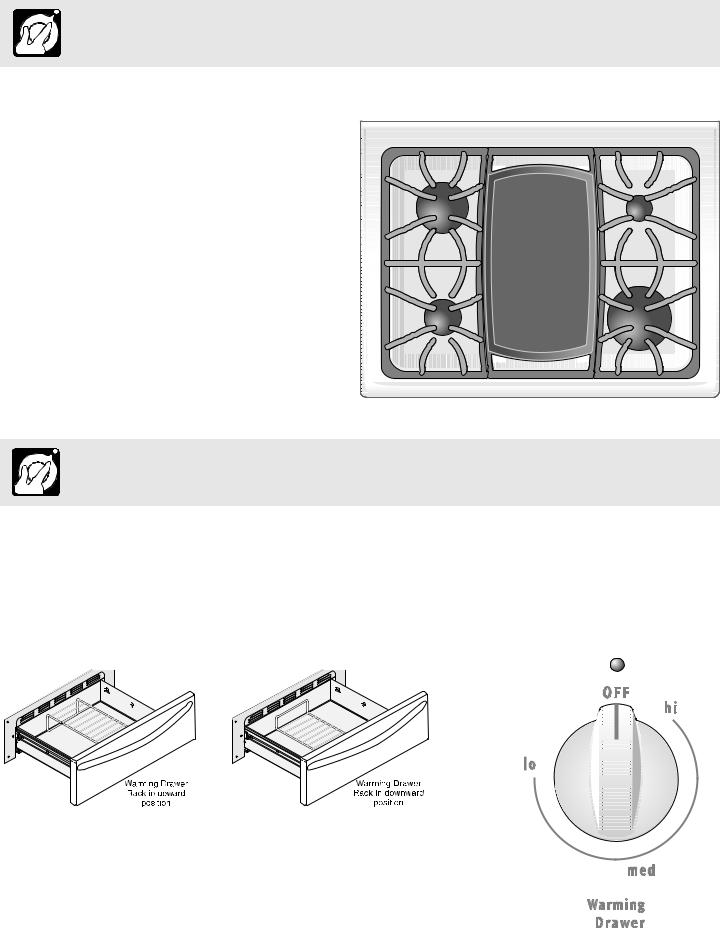
Setting Surface Controls
Care of the Griddle
Before first use:
• Wash Griddle in hot soapy water. Rinse and then dry completely.
After each use:
• Store in a dry place.
• After each use, clean with hot soapy water.
• THE GRIDDLE IS DISHWASHER SAFE.
• Dry Immediately before storing.
Using the Griddle:
• Place the griddle centered over the Bridge Burner (some models). For location refer to Fig. 1.
• Preheat the griddle for 5 minutes on medium to medium low setting. Slow preheat ensures even heat distribution during the cooking process.
• DO NOT preheat the griddle on HI setting. Preheating on HI may warp the griddle and prevent even heat
distribution.
Fig. 1
Setting Warming Drawer Controls
(some models)
Arranging Warming Drawer Rack Positions
The rack can be used in 2 ways:
•In the upright position to allow low profile food items to be placed both under and on top of the rack (for example, rolls or biscuits on top of the rack and a casserole dish underneath).
•In the downward position to allow you to place light weight food items and empty cookware (for example, rolls or pastries and dinner plates) on the rack.
Set the Warming Drawer rack in either position as shown below (Fig. 1).
 Always use pot holders or oven mitts when removing food from the Warming Drawer as cookware and plates will be hot and you can be burned.
Always use pot holders or oven mitts when removing food from the Warming Drawer as cookware and plates will be hot and you can be burned.
Fig. 1
To Operate the Warming Drawer
The purpose of the Warming Drawer is to keep hot cooked foods at serving temperature. Always start with hot food. It is not recommended to heat cold food in the Warming Drawer.
All food placed in the Warming Drawer should be covered with a lid or aluminum foil to maintain quality. Do not use plastic wrap to cover food. Plastic may
melt onto the drawer and be very difficult to clean. Use only utensils and
Fig. 2
cookware recommended for oven use in the Warming Drawer.
8
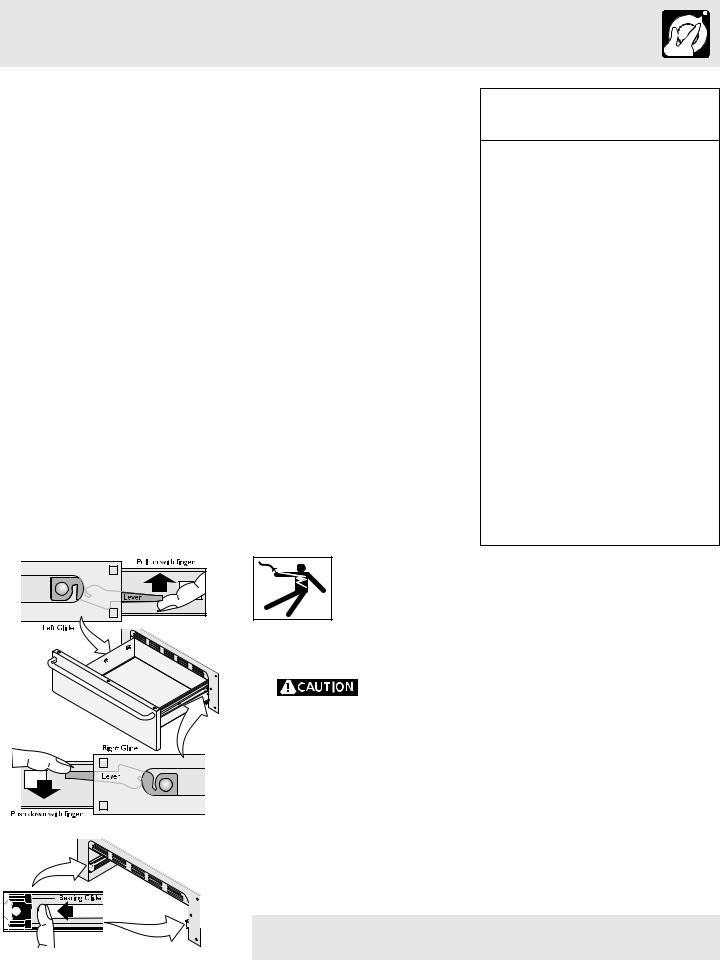
Setting Warming Drawer Controls
Removing & Replacing the Warming Drawer
To Set the Warming Drawer Control
The control is used to select the temperature of the Warming Drawer. It is located on the control panel. To set the control, push in and turn the knob to the desired setting. The temperatures are approximate, and are designated by HI (high), MED (medium) and LO (low). To set the Warming Drawer control:
1.Turn the knob to select the desired temperature setting.
2.For best results, preheat the drawer before adding food. An empty drawer will preheat in approximately 15 minutes.
3.When done, turn the control to OFF.
Warming Drawer Temperature Selection
Recommended Warming Drawer food settings are shown in Fig. 3. If a particular food is not listed, start with the MED setting. If more crispness is desired, remove the lid or aluminum foil from the food. Most foods can be kept at serving temperatures on the MED setting. When a combination of foods are to be kept warm (for example, a meat with 2 vegetables and rolls) use the HI setting. To avoid heat loss, do not open the Warming Drawer while in use.
Warming Drawer Indicator Light
The Warming Drawer indicator light is located above the Warming Drawer
control knob (See Fig. 2). It turns on when the control is set, and stays on until the control is turned off. The Warming Drawer will not operate during the
Self-Clean cycle.
Warming Drawer Recommended
Food Settings Table
Food Item |
Setting |
Bacon |
HI |
Hamburger Patties |
HI |
Poultry |
HI |
Pork Chops |
HI |
Fried Foods |
HI |
Pizza |
HI |
Gravies |
MED |
Casseroles |
MED |
Eggs |
MED |
Roasts (Beef, Pork, Lamb) |
MED |
Vegetables |
MED |
Biscuits |
MED |
Rolls, hard |
MED |
Pastries |
MED |
Rolls (soft) |
LO |
Empty Dinner Plates |
LO |
Fig. 3




 Electrical Shock Hazard can occur and result in serious injury or death. Disconnect appliance from electric power before cleaning and servicing the Warming Drawer.
Electrical Shock Hazard can occur and result in serious injury or death. Disconnect appliance from electric power before cleaning and servicing the Warming Drawer.
To Remove and Replace the Warming Drawer (some models)
To Remove the Warming Drawer:
1. |
Turn power off before removing the Warming Drawer. |
2. |
Open the drawer to the fully opened position. |
3.Locate glide lever on each side of drawer, pull up on the left glide lever and push down on the right glide lever (See Fig.1).
|
4. |
Pull the drawer away from the range. |
|
To Replace the Warming Drawer: |
|
|
1. |
Pull the bearing glides to the front of the chassis glide (See Fig. 2). |
Fig. 1 |
2. |
Align the glide on each side of the drawer with the glide slots on the range. |
3.Push the drawer into the range until levers “click” (approximately 2”). Pull the drawer open again to seat bearing glides into position. If you do not
hear the levers “click” or the bearing glides do not feel seated remove the drawer and repeat steps 1 thru 3. This will minimize
possible damage to the bearing glides.
|
NOTE: The Warming Drawer will NOT operate while in the Self-Clean and “Oven |
Fig. 2 |
Lockout” modes. |
|
|
|
9 |
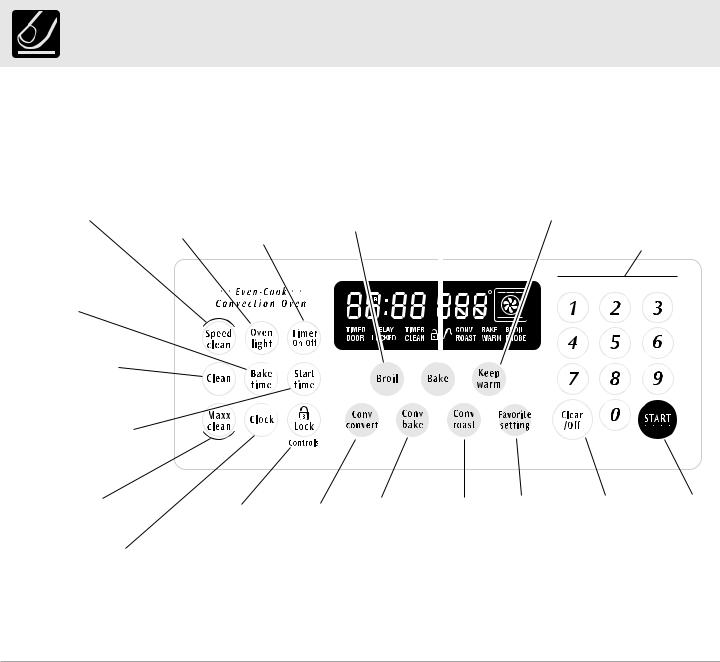
Control Pad Features
READ THE INSTRUCTIONS CAREFULLY BEFORE USING THE OVEN. For satisfactory use of your oven, become familiar with the various features and functions of the oven as described below. Detailed instructions for each feature and function follow later in this Use & Care Guide.
|
OVEN |
|
|
|
|
|
|
LIGHT—Use |
TIMER ON / |
BROIL— Use |
|||
|
to turn the |
|||||
|
OFF— Use to |
to select |
||||
SPEED CLEAN— Use |
oven light ON |
|||||
set or cancel |
variable Broil |
|||||
to select a 2 hour Self- |
and OFF. |
the Kitchen |
feature. |
|||
Cleaning cycle. |
|
Timer. |
|
|
|
|
BAKE TIME— Use to |
|
|
|
|
|
|
enter the length of the |
|
|
|
|
|
|
baking time. |
|
|
|
|
|
|
CLEAN — Use to |
|
|
|
|
|
|
select a 3 hour Self- |
|
|
|
|
|
|
Cleaning cycle. |
|
|
|
|
|
|
START TIME — Use with |
|
|
|
|
||
BAKE, BAKE TIME, and |
|
|
|
|
|
|
CLEAN PADS to |
|
|
|
|
|
|
program a Delayed |
|
|
|
|
|
|
Timed Bake or Delay |
|
|
|
|
|
|
Self-Cleaning cycle. |
|
|
|
|
|
|
MAXX CLEAN— |
LOCK |
|
CONV |
|
CONV |
|
Use to select a 4 |
|
|
||||
hour Self-Cleaning |
CONTROLS CONVERT— |
BAKE— |
||||
cycle. |
Use to enable Use to |
|
Use to |
|||
CLOCK— |
or disable |
select the |
|
select the |
||
Convection |
Convection |
|||||
Use to |
most oven |
|||||
Convert |
|
Bake |
||||
set the |
features. |
|
||||
feature. |
|
feature. |
||||
time of |
|
|
|
|||
|
|
|
|
|
||
day.
BAKE—Use to KEEP WARM— Use |
|
||
enter the |
to select the Keep |
0 THRU 9 |
|
normal Bake |
Warm feature. |
||
feature.. |
|
NUMBERPADS— |
|
|
|
|
Use to enter |
|
|
|
temperature and |
|
|
|
|
|
|
|
times. |
|
|
|
|
CONV |
FAVORITE |
CLEAR/OFF— |
START— |
ROAST— |
SETTING- |
Use to cancel |
Use to |
Use to |
Use recall |
any oven mode |
start all |
select the |
stored |
previously |
oven |
Convection |
recipes. |
entered except |
features |
Roast |
|
the Oven |
(not used |
feature. |
|
Lockout, Time of |
with Oven |
|
|
Day & Minute |
Light). |
|
|
Timer. Press |
|
|
|
CLEAR/OFFto |
|
|
|
stop cooking. |
|
Minimum & Maximum Control Pad Settings
All of the features listed have minimum and maximum time or temperature settings that may be entered into the control. An ENTRY acceptance beep will sound each time a control pad is touched (the Oven Lockout pad is delayed by 3 seconds).
An ENTRY ERROR tone (3 short beeps) will sound if the entry of the temperature or time is below the minimum or above the maximum settings for the feature.
FEATURE |
|
MIN. TEMP. /TIME |
MAX. TEMP. /TIME |
PREHEAT TEMP. |
|
170°F / 77°C |
550°F / 288°C |
BAKE TEMP. |
|
170°F / 77°C |
550°F / 288°C |
BROIL TEMP. |
|
400°F / 205°C |
550°F / 288°C |
KITCHENTIMER |
12 Hr. |
0:01 Min. |
11:59 Hr./ Min. |
|
24 Hr. |
0:01 Min. |
11:59 Hr./ Min. |
CLOCK TIME |
12 Hr. |
1:00 Hr./ Min. |
12:59 Hr./ Min. |
|
24 Hr. |
0:00 Hr./ Min. |
23:59 Hr./ Min. |
COOK TIME |
12 Hr. |
0:01 Min. |
11:59 Hr./ Min. |
|
24 Hr. |
0:01 Min. |
23:59 Hr./ Min. |
STARTTIME |
12 Hr. |
1:00 Hr./ Min. |
12:59 Hr./ Min. |
|
24 Hr. |
0:00 Hr./ Min. |
23:59 Hr./ Min. |
CLEAN TIME |
|
2 hours |
4 hours |
CONVECTION BAKE |
|
300°F / 149°C |
550°F / 288°C |
10
